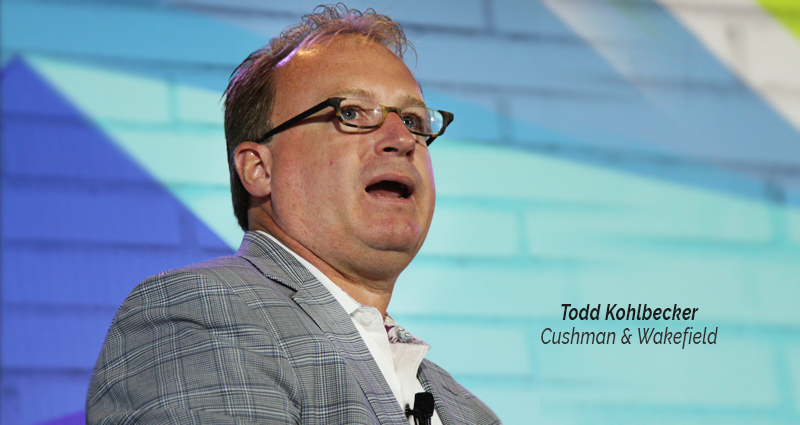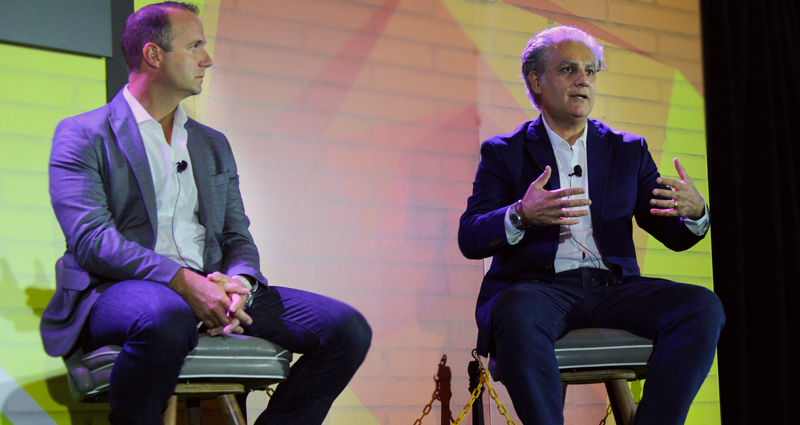
4 a.m. conference calls and constant reinvention are the new status quo as top U.S. brands strive to grow domestically while strategically expanding overseas, according to their development officers.
During a RetailSpaces panel moderated by Todd Kohlbecker, Senior Managing Director at Cushman & Wakefield, the nature of the rapidly changing marketplace was explored. The topics deemed most urgent were optimizing “mature domestic portfolios” and oversaturated markets, designing locations that appeal to savvy young shoppers and making smart moves into overseas markets.
The panel including Kambiz Hemati, Creative Director/Retail Design, Verizon; Bill Mitchell, President, Dunkin’ Brands International; Dan Rieger, VP Real Estate, H&R Block; and Suk Singh, EVP and Chief Development Officer with Bloomin’ Brands, convened to share their current challenges and explore solutions.

Competing with the Convenience of Online Shopping
One such issue was “making stores more human,” in Verizon’s case. “How do we physically transform our stores to match the shopping experience the younger generation has online and on their devices?” asked Hemati.
This concern isn’t limited to the wireless industry. Despite being five miles or less from 97% of the Americans they serve “once a year,” Rieger believes H&R Block could still reach more potential clients – especially younger ones – in the U.S. market. The tax preparation service struggles with:
- Digitally enhancing physical locations and serving consumers who don’t want to be spoken to or “touched,” including those who want to access tax prep software onsite, without interacting with staff.
- Identifying where to focus. Whether to put more time and money into successful locations or “focus on the dogs?”

Restaurant Industry Shrinks
The American casual dining restaurant market is oversaturated, says Singh, whose restaurants include Outback Steakhouse, Bonefish, Carrabba’s Italian Grill, and Fleming’s Prime Steakhouse. Domestically, Bloomin’ is relocating older restaurants from ‘tertiary’ to ‘primary’ locations.
“The challenge with the restaurant industry is you have these zombie restaurants where sales keep on slipping, but as long as there’s cash flowing, the company is going to keep them open,” he emphasizes. “All of a sudden in the last four weeks three restaurant companies have gone bankrupt…It’s going to speed up in the next few years.”
Both he and Dunkin’s Mitchell agree that a potential minimum wage hike could have significant impact on their businesses. “As wages continue to go up, we’re going to have less and less food prep at the restaurant. And get ready for a $40 pizza,” says Singh.

 “Domestically it’s one of the toughest spaces in retail we’re ever seen. Stores will take a big cut with a $15 minimum wage. We’re 100% franchise and it’s going to be tough for our franchisees to make the same money,” Mitchell says. Another key point: With both real estate costs and online sales climbing, the need for old school restaurants is shrinking.
“Domestically it’s one of the toughest spaces in retail we’re ever seen. Stores will take a big cut with a $15 minimum wage. We’re 100% franchise and it’s going to be tough for our franchisees to make the same money,” Mitchell says. Another key point: With both real estate costs and online sales climbing, the need for old school restaurants is shrinking.
“Dominoes is now posting 75% online. With 75% of your customers ordering online, do you even need an oven or just a storefront?”
Design & The International Market
Panelists agreed that for both the domestic and international market, store/restaurant design should be constantly evolving to keep the look fresh, functional and focused on consumer demands.
“I dislike remodeling programs where every seven years you have a new look. You should tweak the design every year for a gradual progression. Plus, this makes you more nimble to address consumer needs,” says Rieger. Another design issue: overwhelming branding/signage. “Once they’re inside, they know where they are. You don’t need to hit them over the head with it.” Rieger adds that opportunities for international expansion vary by brand and service. Many countries and cultures will embrace the expansion of American brands simply because they are “American brands.” However, tax preparation and other service-based brands need to adapt to foreign cultures, shopping/dining habits or (obviously) tax laws to succeed in new environments.
Rieger adds that opportunities for international expansion vary by brand and service. Many countries and cultures will embrace the expansion of American brands simply because they are “American brands.” However, tax preparation and other service-based brands need to adapt to foreign cultures, shopping/dining habits or (obviously) tax laws to succeed in new environments.

Panelists shared the progress of their global expansions. H&R Block has slowly moved into Canada, Australia, Brazil and India. Perhaps surprisingly, both Mitchell and Singh see continued growth in Brazil, despite its political and financial instability. Dunkin is even considering “drone technology” as an option for the Brazilian market; Outback is doing well in Brazil and is eyeing China, a picky market that likes smaller locations and rejects cookie-cutter design.
Hemati, whose career has included top roles at Starbucks and Nike, believes “Design is a very powerful weapon to use. It’s what’s going to make or break the next generation of retail. Making a store local is not that easy. You go to Paris and put a picture of the Eiffel Tower on the wall is not going to work…Everybody talks about being authentic, but nobody does it right.”
At Starbucks, Hemati learned about adapting design to local cultures. “In Korea, people like to go on a date to Starbucks. In France, women like to go to Starbucks because they get more space and they aren’t bothered by a guy with a cigarette who’s trying to pick them up.”
When Nike expanded into China, they incorporated materials that were specifically Chinese. For interiors with a high-school theme, they studied gymnasiums, opting for the local preference (grey bricks) over the stereotypically American red brick. As customers absorb the details, they get the message: “We’re American, but we understand you.”
Generation Z Demands Perfection/Ease
From donuts and coffee to cell phones, the panelists pinpointed a challenge – making onsite shopping as convenient for the younger generation as shopping online.
“When I was at Nike the younger generation – especially girls – didn’t want anyone to talk to them when they came in the store because they already knew what they wanted,” says Hemati. “They wanted to touch it, feel it, try it on then talk to somebody. They thought they had more information than the salesperson. How do we match the online experience to the in-store experience?”

The speed and convenience of Amazon have even spoiled the in-store shopping experience for older consumers like him. “You go to Staples looking for paper clips and it’s daunting…So many aisles. You have to find somebody to help you,” he adds.
“Regardless of brand, technology, consumer interface and the table stakes, anything this new generation touches has to be perfect. Experience at the counter is a game changer,” stresses Mitchell, who admits that in many ways his brand’s efforts to anticipate the “wants and needs” of Millennials have failed. “So our conversations…are around Generation Z. What does that look like and what do we need to do there?” For him, a long conversation with the head of Amazon confirmed his thoughts about service: “The UBERiztion of life is a real term. We’re looking at developing countries without brick & mortar.”
Singh believes that while many aspects of service are changing (“Twenty years ago there wasn’t technology, now more and more of our budgets are consumed by technology. Five years ago, Uber didn’t exist; now it’s all I use.”), core essentials endure. “At my restaurants, the priorities continue to be reducing wait time, making sure drinks are served quickly and reducing the time customers wait to receive their checks.”
Key Takeaways:
A New Minimum? For restaurants, a higher minimum wage could mean cutting staff and handling more food prep offsite.
Zombie Restaurants. Expect to hear death rattles from restaurant chains that have been living on borrowed time for years. Bankruptcy filings have begun & will pick up steam in 2017.
7 Year Itch? More Like 7-Month or 7-Day... For restaurants and retailers, the rule about redesigning Every 7 Years is Obsolete. Instead, owners should be refining/upgrading brick & mortar locations constantly, focusing on gradual improvements rather than massive overhauls.
Before Moving Overseas—Study Your Market! Successful International Expansion requires more than just shipping the same brick & mortar box from Dubuque to Delhi or Dubai. Adapting to international markets requires research, cultural respect and adapting your brand, services and design aesthetic to local markets. “Everybody talks about being authentic, but nobody does it right.”
Gen Z. Younger shoppers (most ages, really) want in-store shopping to mirror Amazon. And they usually know more about the product than sales associates and don’t like being bothered until they’re ready to buy.
Droning On. As it expands into the Brazilian market, Dunkin is considering drone technology to facilitate delivery.
Watch the video of the panel below. Enjoy!
Posted by
Physical Retail Reimagined.
RetailSpaces is a community for store development and design innovators.
March 29-31, 2026 | San Antonio, TX
Learn More!








Comments